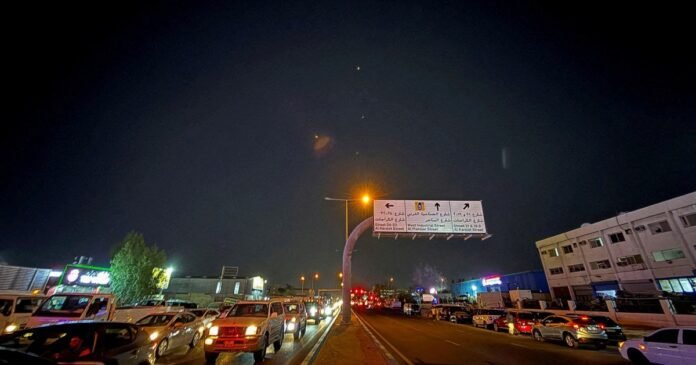Even as the missiles flew across the waters separating Iran and Qatar, diplomacy was in motion. And it worked.
When United States President Donald Trump entered the war between Israel and Iran late on Saturday night, the region was braced for escalation.
The US dropped 17 Massive Ordnance Penetrator bombs and two dozen cruise missiles on Iran’s nuclear facilities at Natanz, Fordow and Isfahan, assisting Israel, which had already been trading missile fire with Tehran since July 13.
Iran’s response soon came. On Monday evening, it launched 14 missiles aimed at the US Air Force’s Central Command in the Middle East, at Al Udeid in Qatar, a neutral country. Those missiles flew over the capital, Doha, spreading alarm.
Yet instead of leading to the “rathole of retaliations” UN Secretary-General Antonio Guterres had warned against, the attack presaged a truce that Trump announced hours later, and that was facilitated by sophisticated diplomacy involving Qatar, the US and Iran.
So, how did a ceasefire emerge from the smoke of an attack?
A military response against a US base was an obvious choice because the US has exposure in Iran’s neighbourhood.
Apart from Al Udeid airbase, its Fifth Fleet is headquartered in Bahrain. Both are just more than 200km (125 miles) across the Gulf from Iran. There is also an air base in Kuwait and four logistics air bases in Oman. Further afield, the US has three air bases in Saudi Arabia, three air bases in Iraq, and an air base in Jordan.
“The US has 40,000 troops in the region [on] 19 US bases, eight of which are permanent, and Iran has said previously they will become legitimate targets if the US strikes Iran,” said media’s Dorsa Jabbari.
But the proxy attacks never came, demonstrating the limitations of Iran’s so-called “Axis of Resistance”, and “how exhausted it is after months of fighting the United States and Israel”, said the ISW in a comment on its website.
Still, even as the world prepared for Iran to respond to the US attacks, an Iran historian at St Andrews University in the UK, told media on Monday that he thought “an ‘off-ramp’ with the United States” was likely.
“There will be a lot of public bluster, but privately, I think feelers will be put out,” he said, before the Iranian strike later that evening.
At about 7pm local time (16:00 GMT) on Monday, Iran struck Qatar.
Qatar condemned the attack as “an extremely dangerous escalation that represents a flagrant violation of the sovereignty and territorial integrity of the State of Qatar”. It issued a demarche to the Iranian ambassador in Doha.
What options did Iran have?
But the “feelers” Ansari had talked about appear to have been put out beforehand.
“I want to thank Iran for giving us early notice,” wrote Trump on social media, “which made it possible for no lives to be lost, and nobody to be injured.”
Satellite images suggested the US had evacuated staff and aircraft from Al Udeid before it struck Iran, so targeting it represented a low risk of casualties. The US base at Al Udeid and the Qatari Air Force suffered few material losses.
“I am pleased to report that NO Americans were harmed, and hardly any damage was done. Most importantly, they’ve gotten it all out of their ‘system’,” wrote Trump three hours after the attack.
A mere two hours later, he announced the ceasefire.
“CONGRATULATIONS TO EVERYONE! It has been fully agreed by and between Israel and Iran that there will be a Complete and Total CEASEFIRE (in approximately 6 hours from now, when Israel and Iran have wound down and completed their in progress, final missions!),” Trump wrote on Truth Social, his social media platform.
Trump later revealed that “Israel & Iran came to me, almost simultaneously, and said, ‘PEACE!’”
Iran’s government was eager to put the war behind it, issuing a statement early on Tuesday saying it had delivered a “humiliating and exemplary response to the enemy’s cruelty”, and framing the ceasefire as a “national decision to impose the cessation of war on the Zionist enemy and its vile supporters”.
Qatar hosts the largest US airbase in the Middle East and has worked closely with Washington on a series of tricky diplomatic negotiations, involving the Taliban in Afghanistan and Hamas in Gaza, among others.
At the same time, it enjoys warm diplomatic and economic ties with Iran. “The South Pars and North Pars and North Field have been a joint [venture] for a long time – over 25 years,” Doha-based energy expert Roudi Baroudi told media, referring to gas fields that Qatar and Iran share.
The South Pars gas field alone holds almost as much gas as all the other known gas fields on the planet, said Baroudi.
Right after he announced the ceasefire, Trump thanked the emir of Qatar.
“I’d like to thank the Highly Respected Emir of Qatar for all that he has done in seeking Peace for the Region,” he wrote on Truth Social. Meanwhile, Iranian President Masoud Pezeshkian telephoned the Qatari emir on Tuesday to express “regret” over the attack the previous day.

